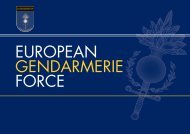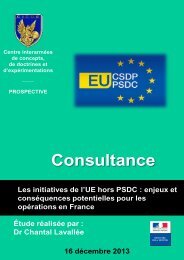Conference
science-research-bulletin-2013-conference
science-research-bulletin-2013-conference
You also want an ePaper? Increase the reach of your titles
YUMPU automatically turns print PDFs into web optimized ePapers that Google loves.
EUROPEAN POLICE SCIENCE AND RESEARCH BULLETIN<br />
SPECIAL CONFERENCE EDITION<br />
Existing guidance to the UK police about the<br />
use of intelligence about potential public unrest<br />
recommends the use of both conventional<br />
qualitative and quantitative indices. COSMOS<br />
proposes that analysis of social media<br />
communications is also used. They believe it may<br />
reorient both police and public understanding<br />
of tension and social cohesion through reference<br />
to the mass of user-generated accounts of social<br />
problems in particular contexts and in near,<br />
and possibly real, time. If the social media can<br />
be adequately sampled and used to indicate<br />
‘offline’ behaviour, the analysis of this kind of<br />
data could be a revelation in broadening public<br />
understanding of civil unrest and attenuating<br />
dependence on elite, retrospective, constructions<br />
of social problems.<br />
The COSMOS paper concludes that extremes in<br />
positive and negative sentiment are not directly<br />
related to tension and that tension detection<br />
requires more than sentiment analysis alone.<br />
Both sets of results provide evidence that their<br />
social media tension-monitoring techniques are<br />
faster than human coders, and can handle more<br />
data, and are more accurate than other machine<br />
supported classification engines.<br />
It is apparent that sound conclusions based on<br />
these new methodologies are likely to be limited<br />
in their scope. This looks like the beginning of the<br />
development of operationally effective analytical<br />
tools, not the end of it. The use of social media<br />
fits into a context in which there are also existing<br />
sources, and that means that there is a need for<br />
examination about how the organisation uses<br />
information in order to make decisions. This<br />
takes us outside the realm of computer scientists.<br />
3.2 NETWORKS, STYLE AND IMPACT<br />
In 2010, I did a very short piece of research<br />
into the use of social media by the UK police<br />
for citizen engagement (Crump 2011). I relied<br />
heavily on the work which Nick Keane (now<br />
of the UK College of Policing) had done in<br />
bringing together practitioners in UK police<br />
forces, and in mapping the extent to which the<br />
various forces were exploiting this opportunity.<br />
What I particularly wanted to look at was how<br />
notions of online community related to that of<br />
community policing, since it was in the context<br />
of neighbourhood policing that forces were<br />
experimenting with allowing front line officers to<br />
manage accounts on behalf of the force. I wanted<br />
to ask the question of how large were the Twitter<br />
networks that were being formed, who was in<br />
them, and how far did they create new forms<br />
of interaction rather than replicating traditional<br />
forms of police/public communications in new<br />
contexts. This was before the 2011 riots changed<br />
the seriousness with which police leaders took<br />
social media, and the size of the samples and the<br />
number of interviews I could carry were limited,<br />
so any conclusions were tentative.<br />
What I did conclude was that, while most<br />
networks were small, and the extent of two<br />
way communication was limited, there was<br />
scope for police forces to do more analysis of<br />
who their followers were in terms not only of<br />
their real world influence but also in terms of<br />
their influence within networks and look at<br />
strategies for building engagement with them.<br />
COMPOSITE has undertaken work on the use<br />
of Twitter during the London riots which is<br />
described as ‘…a first step into detailing how<br />
disparate adoption and usage patterns of Twitter<br />
emerge during crises’ (Denef et al. 2013). This<br />
work also provides a first indication of the effects<br />
on image and relationship with the public.<br />
3.3 SOCIAL MEDIA AND THE CULTURE OF<br />
POLICE ORGANISATIONS<br />
The discussion of the work of the COSMOS<br />
programme already hints at the need to begin<br />
work on organisational issues which relate to the<br />
social aspects of technology adoption as well as<br />
the computer science issues. On the whole, this<br />
aspect of the study of social media in policing<br />
has yet to be systematically addressed although<br />
the range of issues for investigation is broad.<br />
(Bartlett et al. 2013).<br />
There is of course a long tradition of studies of<br />
police occupational culture. There have been a<br />
number of studies framing issues of innovation,<br />
and resistance to it, in terms of knowledge<br />
and information. For example, Helen Gundhus<br />
(2013), in a study of change in knowledge<br />
management in the Norwegian Police Academy<br />
finds that new knowledge regimes are met with<br />
resistance, not only because the stubbornness<br />
of police occupational culture, but also because<br />
they threaten what is perceived as meaningful<br />
professional practices.<br />
It is certainly a testable hypothesis, for example,<br />
that the introduction of social media analysis to<br />
110





